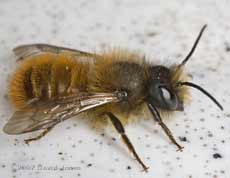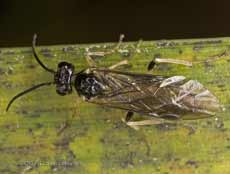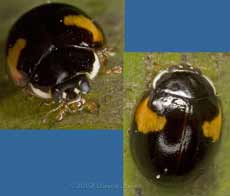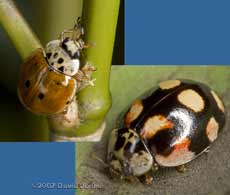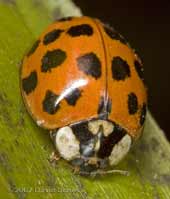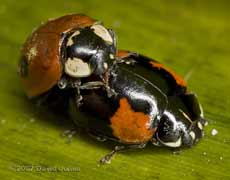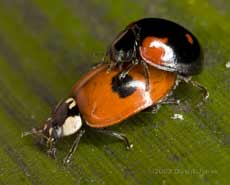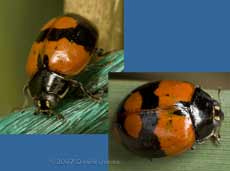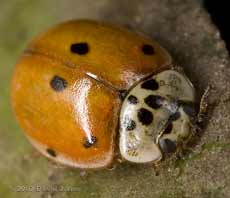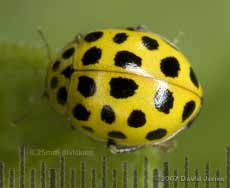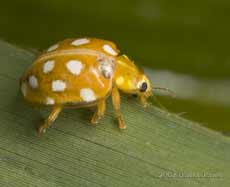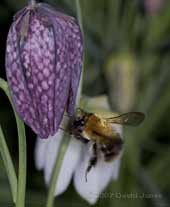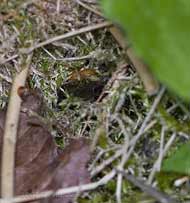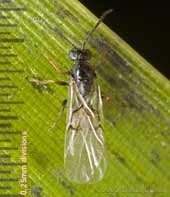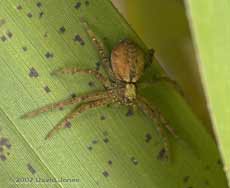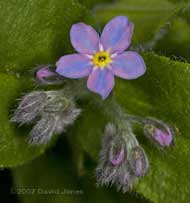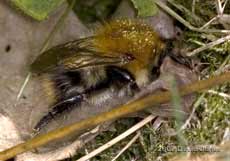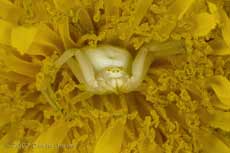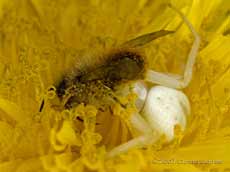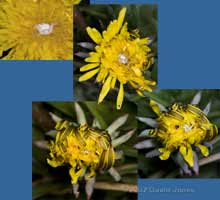Go to the last entry on this page .....Go to previous entry1 April - The new month has started sunny and the temperature reached 16C this afternoon, but the cold wind, almost as strong as yesterday but from the North-east now, made it feel much cooler.
This one certainly does appear to be a male Osmia Rufa, although it's face hairs don't seen to be light enough. In fact. it has some black hairs that my guide notes as present on the female. However I cannot see the horns that the female possesses and uses to shape mud in her nest.
This fly ( an ichneumon fly, I think, but I cannot tell which species) stayed on a bamboo leaf despite the wind and even with me holding the leaf as I took the photograph.
Finally, a ladybird - I think this is probably another 2-spot Ladybird, although the black, melanic forms usually have four spots. Thanks to Peter Brown, Ladybirds Survey Project Officer at the Biological Records Centre for correcting this ID for me - it is actually a 10-Spot Ladybird.
2 April - A beautiful, sunny day with the temperature getting up to just over 17C. I could have spent all day in the garden, but instead took advantage of the mildness to open all the downstairs windows while I stripped many layers of old paint from some woodwork - the pause in the refurbishing work had to come to an end at some time!
They are both 10-Spot Ladybirds, and as usual, found on a bamboo plant. The top one is a faintly-spotted typical form (which was moving too quickly to get a decent photograph), and the lower one a chequered form. There was also a typical one with ten clearly defined spots but it took off before I could get close to photograph it.
At the moment, it's the 2-Spot Ladybirds that hold the majority in the garden, and I must have seen a couple of dozen of them today, and just one 7-Spot Ladybird as well. Three type of butterfly made an appearance today too, a Brimestone (a regular on sunny days, although it rarely lands), a Large White, and a small brown butterfly that Sheila spotted.
6 April - A bit of catching up to do! Over the last couple of days the weather has remained dry, the wind has dropped (although still from the north) and the daytime temperatures have started to climb. The day before yesterday it reached just 11C, yesterday afternoon was a very pleasant 17C, and today could be even warmer (fingers crossed!) - in fact it reached 17C again, and slightly more of a breeze. Nevertheless it was good enough for us to have lunch down on the West Wing for the first time this year, serenaded by the male Blackbird (his partner is now nest building in our Ivy tree)!
Unfortunately it made an escape before I had chance to catch it, and I haven't seen it since. Spectacular as they are, this is one species I do not want to see too often in the garden if it means that our native species will suffer.
Talking of which, there are quite a few of those native ladybirds about at the moment, with 2-Spots continuing to be the most common by far, with a number of mating pairs like these,
and these, and even 'normal' red with black spot pairs - I have yet to see a mating pair of black melanic variants.
This is probably the most striking variant I'm seeing at the moment.
Yesterday I managed to get a few better pictures of the feint-spotted typical 10-Spot Ladybird - this time it kept still for me.
Today I had to rescue another ladybird from the pond. Much smaller than the Harlequin, but just as spectacular, this is a 22-Spot Ladybird (Psyllobora 22-punctata). Unlike the Harlequin which is extremely variable in its markings, this ladybird seems to have a strict 'dress code'. It feeds on mildew on low-lying plants, which leads me to my other ladybird picture for today -
My first Orange Ladybird of the year. This one was dashing about the foliage of the bamboo next to the Birch tree where I hope to see the population recover this year after last year's disappointing decline.
There are no new solitary bee sightings to report, but I'm pleased to say that we do seem to have a bumblebee nesting. It appears to be a Carder Bee, possibly a Moss Carder Bee (Bombus muscorum) or a Shrill Carder Bee (Bombus sylvarum).
In several past years they have nested in a clump of moss at one end of the big pond, and this rather indistinct image shows its tail-end disappearing down a hole into that moss. The unusual thing to note about these two photographs is that they were taken at just after 8pm, and even with the evenings getting lighter I needed to use my torch to aid with focusing!
I continue to see Ichneumon flies, similar to those I have already photographed, on the bamboos, but on the 4th I spotted this different insect which I think is one of the gall wasps, although I haven't had time to try identify it.
And another hunting spider for the record, this time on a bamboo plant yesterday
The flowers usually start off pink because of the acidity of their cell sap, and become blue as that sap turns neutral or alkaline. My flower guide describes that happening in 'older' flowers, although I often see the change happening quite soon after the flower opens. This flower has been photographed mid-way through that change.
7 April - A rather disappointing day, with high cloud filtering out much of the sunshine, and keeping the temperature down to below 15C.
On the basis of today's pictures I'm more inclined to think it is Shrill Carder Bee, although I'm not sure that its 'buzz' is distinctively high pitched (and my hearing isn't too bad!).
It's a female Misumena vatia (the male is much smaller and has dark markings). It seems that these spiders can actually change colour slowly between white, yellow and greenish (as well as sometimes having red markings) which is very useful as they usually sit in white or yellow flowers, waiting to ambush visiting insects.
This individual was successful during the early afternoon, catching a solitary bee. I assume that it discarded the remains as there was no sign of the bee a few hours later.
I kept on checking the spider at the end of the afternoon, wondering what it would do as the flower closed for the night, and was surprised to see the spider staying put as the flower closed around it. I shall try to remember to check if it's still there when the dandelion re-opens in the morning.
And one last thing to record -yesterday I had the first signs of hay-fever and today it has struck with a vengeance - the tree pollen season is underway, and a likely source of pollen is my neighbour's Silver Birch tree which I see has now got catkins.
Click on images to see larger versions |
|
